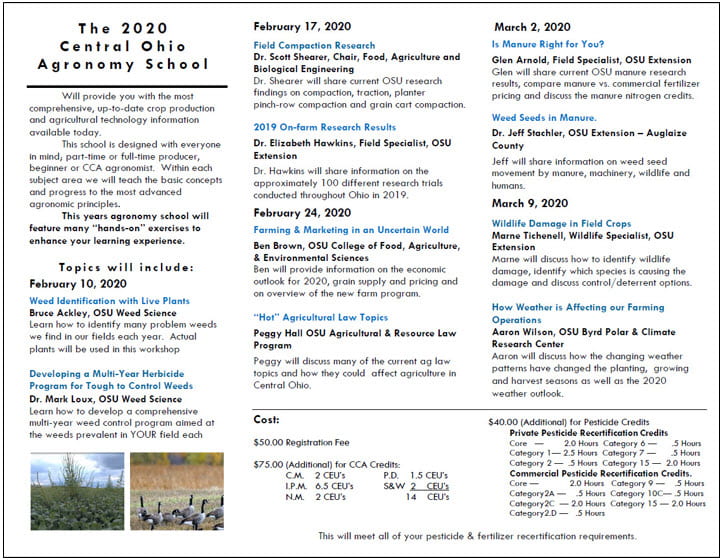 With the colder weather, some livestock producers will be applying manure on frozen ground. Here are some things to keep in mind. For the article below, frozen ground would be soil that you cannot inject the manure into or cannot conduct tillage within 24 hours to incorporate the manure.
With the colder weather, some livestock producers will be applying manure on frozen ground. Here are some things to keep in mind. For the article below, frozen ground would be soil that you cannot inject the manure into or cannot conduct tillage within 24 hours to incorporate the manure.
Permitted farms are not allowed to apply manure in the winter unless it is an extreme emergency, and then movement to other suitable storage is usually the selected alternative. Several commercial manure applicators have established manure storage ponds in recent years to help address this issue.
In the Grand Lake St Marys (GLSM)watershed, the winter manure application ban from December 15th to March 1st is still in effect. Thus, no manure application would normally be allowed in this time period.
For producers in the Western Lake Erie Basin (WLEB) watershed, the House Bill 1 rules established in 2016 are still in effect.
The Natural Resource Conservation Service (NRCS) Code 590 was revised in 2020 and now applies statewide in Ohio (except to GLSM & WEBL). It states the surface application of manure on frozen and snow-covered soil is not acceptable unless it is an emergency. An emergency exists as a temporary situation due to unforeseen causes and after all other options have been exhausted. In this situation only limited quantities of liquid manure shall be applied to address manure storage limitations until non frozen soils are available for manure application. The Ohio Department of Agriculture will only enforce NRCS 590 in counties outside of GLSM and WELB if there is a manure discharge from the field. If a citation is issued for a discharge, it will be based on the 590 standards.
All applications of liquid manure to frozen and snow-covered soils must be documented in the producers’ records and must be applied in accordance to ALL the following criteria:
• The rate of application shall not exceed the lesser of 5,000 gallons/acre or P removal for the next crop.
• Applications are to be made on land with at least 90% surface residue cover (cover crop, good quality hay or pasture field, all corn grain residue remaining after harvest, all wheat residue cover remaining after harvest).
• Manure shall not be applied on more than 20 contiguous acres. Contiguous areas for application are to be separated by a break of at least 200 feet.
• Apply manure to areas of the field with the lowest risk of nutrient transport such as areas furthest from streams, ditches, waterways, with the least amount of slope.
• Application setback distance must be a minimum of 200 feet from grassed waterways, surface drainage ditches, streams, surface inlets, water bodies and 300 feet minimum from all wells, springs and public surface drinking water intakes. This distance may need to be further increased due to local conditions.
• For fields exceeding 6% slope manure shall be applied in alternating strips 60 to 200 feet wide generally on the contour, or in the case of contour strips on the alternating strips.
For farmers with solid manure, stockpiling could be an option. There are two different types of stockpiles: Short term and long term.
The short-term stockpile information can be found in NRCS FOTG 318 Short Term Storage of Animal Waste and Byproducts Standard (“NRCS 318”). Essentially, short term stockpile is a pile of solid manure that is being kept temporarily in one or more locations. It is considered a temporary stockpile as long as the pile is kept at the location for no more than 180 days and stockpiled in the field where the manure shall be applied. Setback distances listed in NRCS 318 should be followed to prevent discharge to waters of the state. There are multiple recommendations listed in NRCS 318 that speaks to location, timing, and preventative measures that should be taken while stockpiling the manure short term.
The long-term stockpile information can be found in NRCS FOTG 313 Waste Storage Facility Standard (“NRCS 313”). Long term stockpile is directly related to solid manure being piled and kept at a facility for longer than 180 days at a permanent location. It is recommended that all permanent long term storage stockpiles should be following the guidelines in NRCS 313 with the utilization of a stacking facility and the structural designs of fabricated structures. A stacking facility can be open, covered or roofed, but specific parameters should be in place to prevent manure runoff from the site. These recommendations are listed in the NRCS 313.
Regardless of your county, it’s probably best to check with your local Soil and Water Conservation District office before considering winter manure application in Ohio. The rules have changed, and you should become aware of those that affect your operation.









